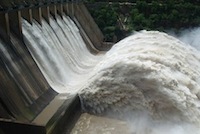Carbon Reduction Strategies
Energy from Sustainable Resources
Increasing amounts of carbon (as CO2) in the atmosphere is rapidly changing Earth’s climate. Emissions from fossil fuel burning are continually increasing the amount of CO2 in the atmosphere. Natural processes can only absorb about half of those emissions into oceans and the land. The rate of CO2 emissions has to be reduced to less than 20% of the current CO2 emission rate to allow the land and oceans to absorb CO2 as fast as it is emitted without leaving excess CO2 in the atmosphere.
One method of reducing carbon emissions is to harness energy from naturally occurring, sustainable resources. In recent history, we've been developing methods to capture energy from such sources because they do not have a limited supply and they can be replenished in a short period of time.
 |
SOLAR ENERGY: Solar energy is energy from the sun. When the sun’s energy reaches the earth in the form of sunlight, it can be converted into electricity. |  |
HYDROELECTRIC ENERGY: Hydroelectric energy is energy derived from the movement of water. Water flows and falls downward due to gravity. As it moves, it has kinetic energy which can be harnessed. |
 |
WIND ENERGY: Wind energy is energy from moving air. Air has mass. When it moves, it has kinetic energy. Kinetic energy is the energy of motion. |  |
GEOTHERMAL ENERGY: Geothermal energy is heat extracted from the Earth’s interior. The Earth has an internal heat that is due mostly to the radioactive decay of minerals inside the Earth’s core and mantle. |
 |
TIDAL ENERGY: Tidal energy is energy derived from the movement of the ocean tides. Since water has mass, when it moves, it has kinetic energy which can be harnessed. |  |
BIOFUELS: Biofuels are made from plants. Biofuels are being produced from used cooking oils, or derived from plants as ethanol, a type of alcohol. |
